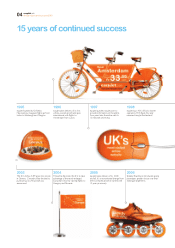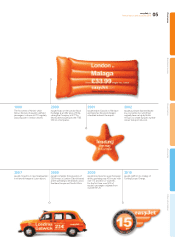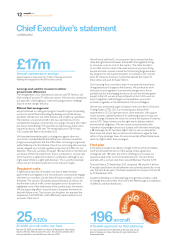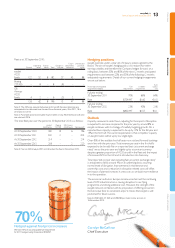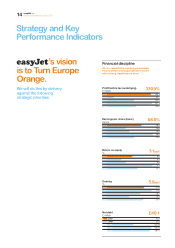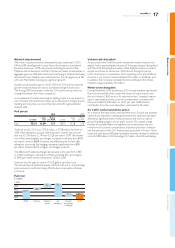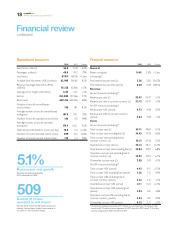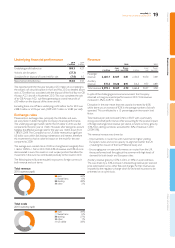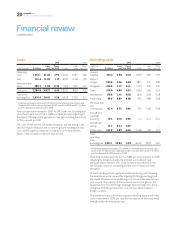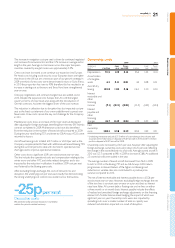EasyJet 2010 Annual Report Download - page 13
Download and view the complete annual report
Please find page 13 of the 2010 EasyJet annual report below. You can navigate through the pages in the report by either clicking on the pages listed below, or by using the keyword search tool below to find specific information within the annual report.
Mainland Europe
Growing our footprint through increased based
capacity in Switzerland, France and Italy
In Switzerland three new aircraft were introduced and seats own
grew by 12%. Frequencies were increased on routes such as Geneva to
London Gatwick, Paris Orly and Barcelona. An A320 was introduced at
Geneva to enable ights to longer range destinations such as Sharm El
Sheikh. easyJet also took advantage of Ryanair’s retreat from Basel to
addadditional capacity into the market.
France is a compelling investment opportunity for easyJet. Low cost
carrier penetration is half the European average and easyJet is uniquely
positioned to grow in France due to its decision to put its crew onto local
terms and conditions. easyJet grew capacity by 22% in France in the year,
against market growth of just 1%. At Paris Orly, easyJet has added a
seventh aircraft and now has ten aircraft deployed at Paris Charles
DeGaulle. At Lyon, a third aircraft has been added as we have taken
advantage of Air France’s reduced capacity on routes such as Madrid
andBarcelona; a fourth aircraft will be added over the winter.
Capacity in Italy increased by 25%, with 16 aircraft now based at Milan
Malpensa where easyJet launched eight new routes and increased
frequencies on business routes such as Rome, Madrid, Barcelona
andAmsterdam.
Growing our footprint through increased inbound
flying in Germany and Spain
In Germany, easyJet continued to refocus its offering. We have increased
capacity on key business routes out of Berlin such as Brussels,
Copenhagen and London Gatwick. easyJet has also increased its
presence in Scandinavia and we now have thirteen routes operating
out of the region.
In Madrid, capacity grew by 20% in the period, with eight aircraft now
deployed there. The Spanish market continues to be competitive
however both city and beach in-bound routes continue to perform well.
Portugal is an important market for easyJet and we are already its
secondlargest airline. In October, we announced that we are opening
abase at Lisbon in winter 2011. This will enable us to further develop
ourbusiness there.
Ancillary revenues
Ancillary revenues grew in the year by 43 pence per seat to £10.20
despite regulatory changes to the sales process for insurance products
which led to a reduction in insurance income of £8 million in the year
andchanges in VAT legislation which negatively impacted in-ight income
by £2 million. There were improved performances in fees and charges
and bag revenue.
However, hotel and car hire revenues were down versus the prior year.
This performance is disappointing and we are reviewing this area to
ensure that we have the correct product offerings to underpin our
growth plans going forward.
Smart cost management
It is vital that easyJet effectively manages its cost base so that it can
continue to offer competitive fares protably. However, it is important
that cost management is sensibly executed and does not lead to
sub-optimal decisions such as those made around crewing this year.
Total cost per seat excluding fuel, rose by 5.2% at constant currency to
£36.15 in the period, principally due to disruption and wet leasing costs.
Excluding the effect of additional disruption, cost per seat rose by 2.2%
at constant currency to £35.14 as improvements in aircraft ownership
and maintenance costs partially offset increased airport and navigation
charges. We are making good progress to be on track to deliver against
our £190million savings programme.
Systems implementation to drive reduced fuel consumption
and improvements in crew efciency
easyJet has maintained the level of fuel burn in the period. Whilst crew
productivity savings were delivered in the year, the way in which these
savings were achieved drove substantially more cost in the business as
we suffered disruption due to crew shortages in part of the network.
Consequently, we have decided to stabilise the operation during 2011
and have built more resilience into our crew planning. These additional
costs will be offset by reduced disruption and wet leasing costs.
20%
Capacity growth in Madrid
In Madrid, we have 8 aircraft and increased
capacity by 20% in the year.
easyJet grows French capacity
We increased capacity in the year by 22%
against a total market growth of only 1%.
22%
Overview Business review Governance Accounts Other information
11
easyJet plc
Annual report and accounts 2010





